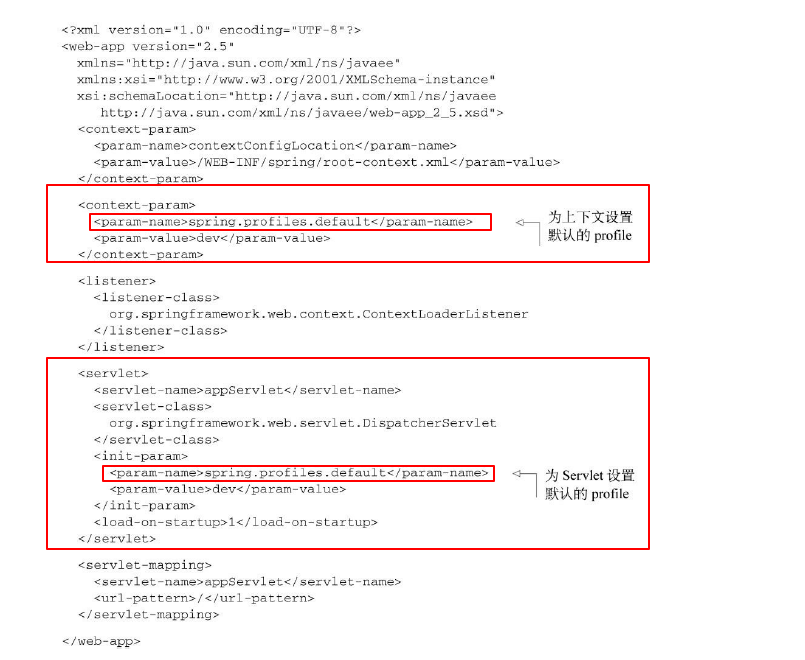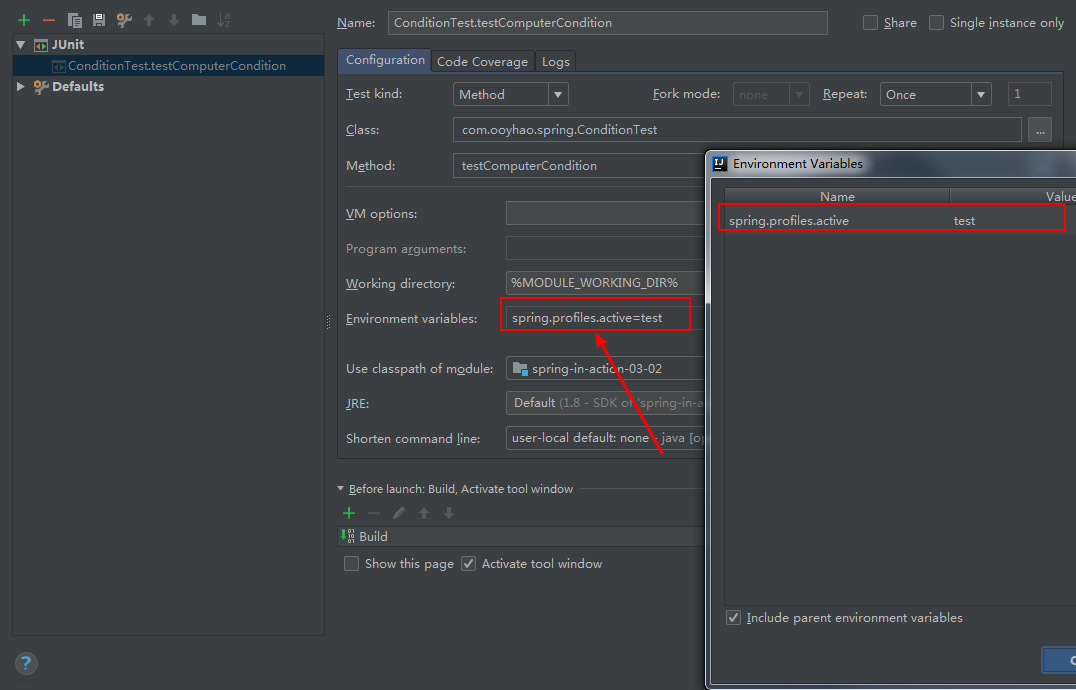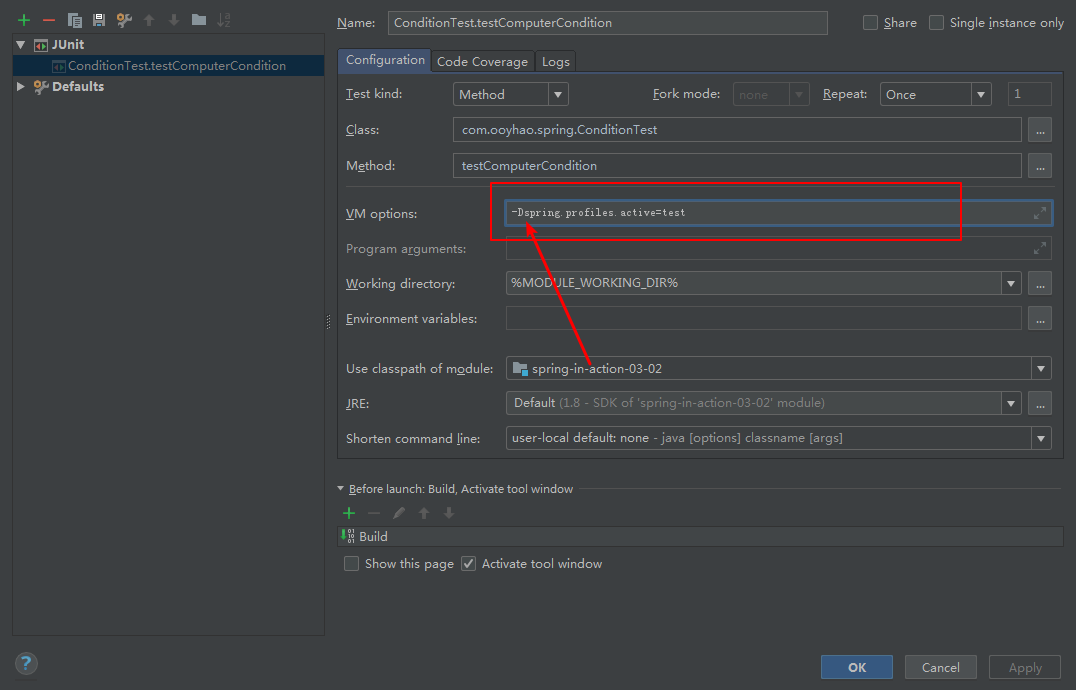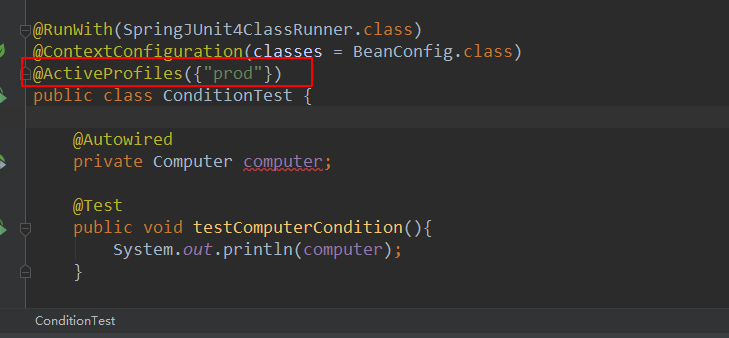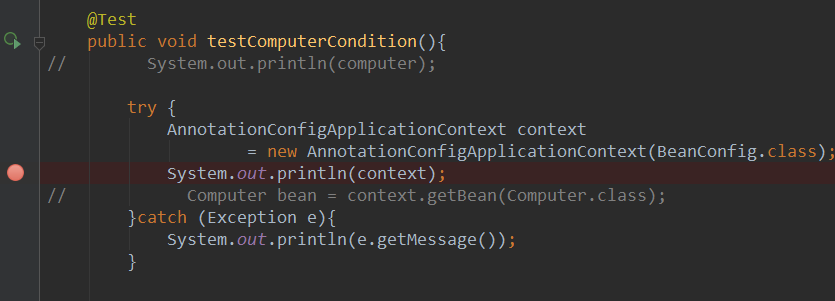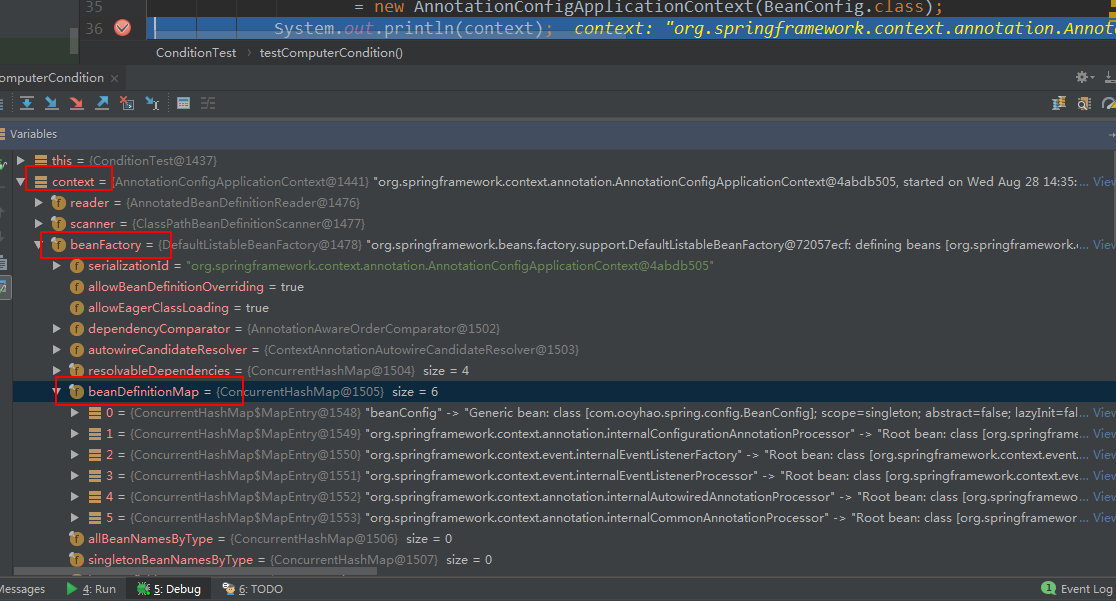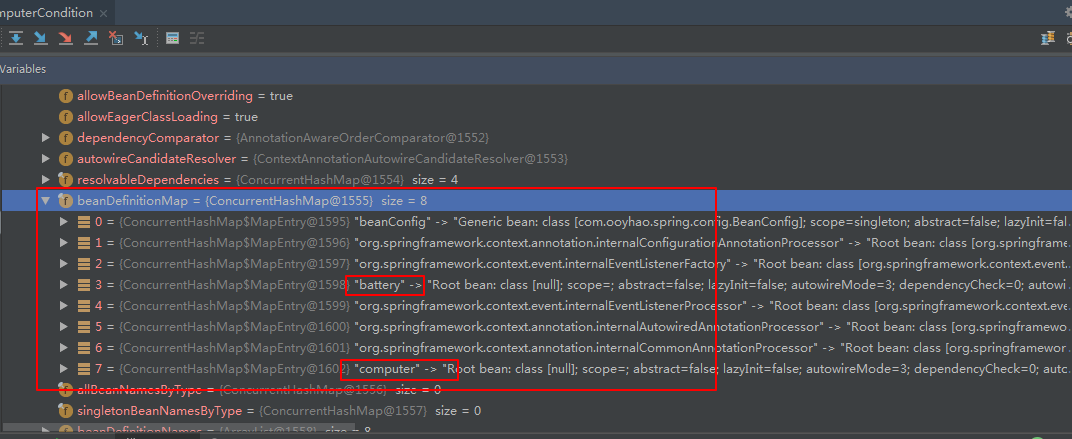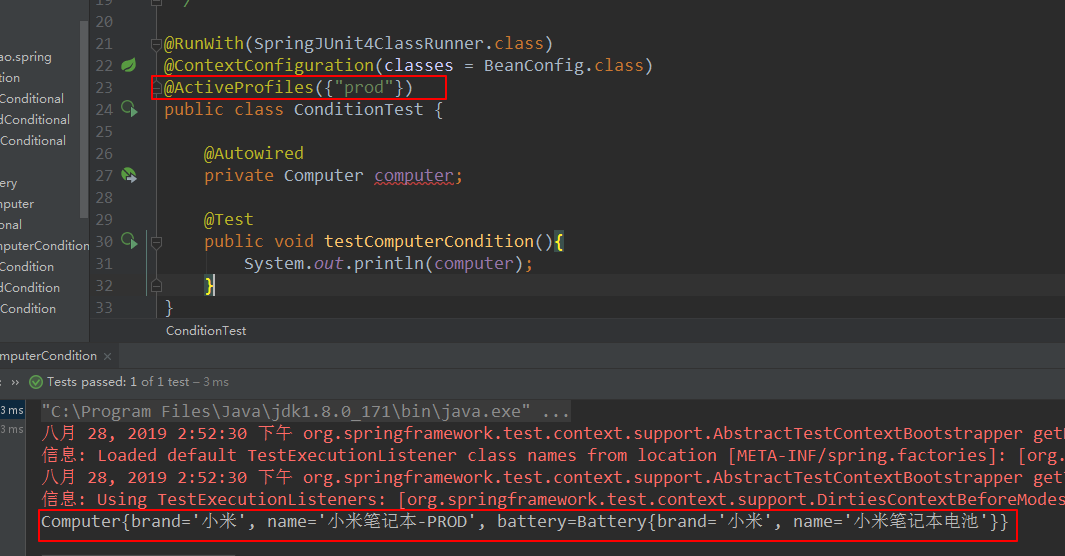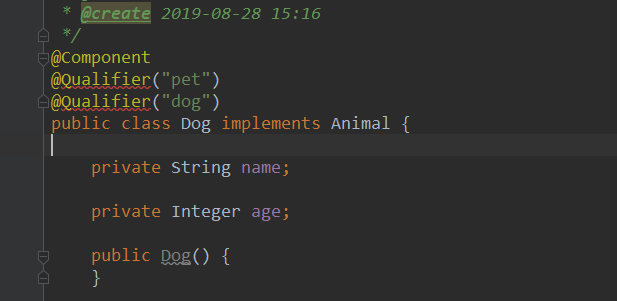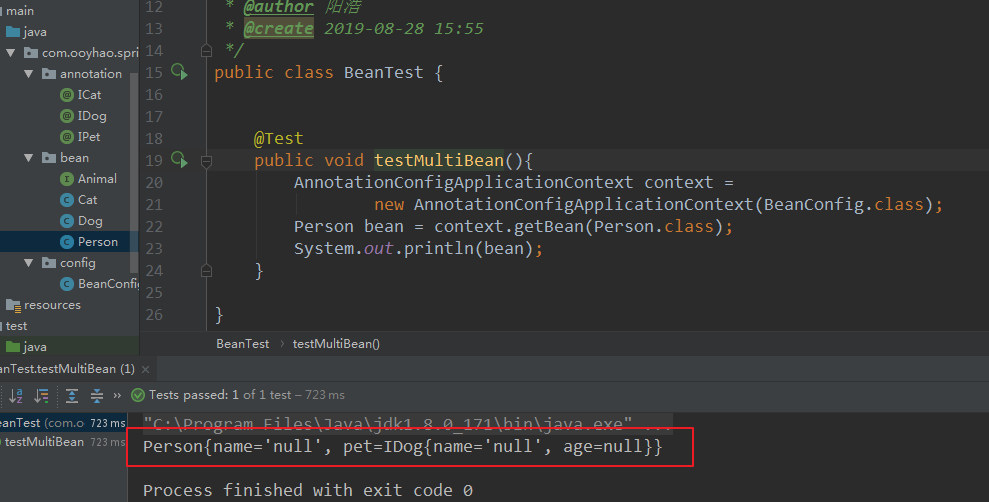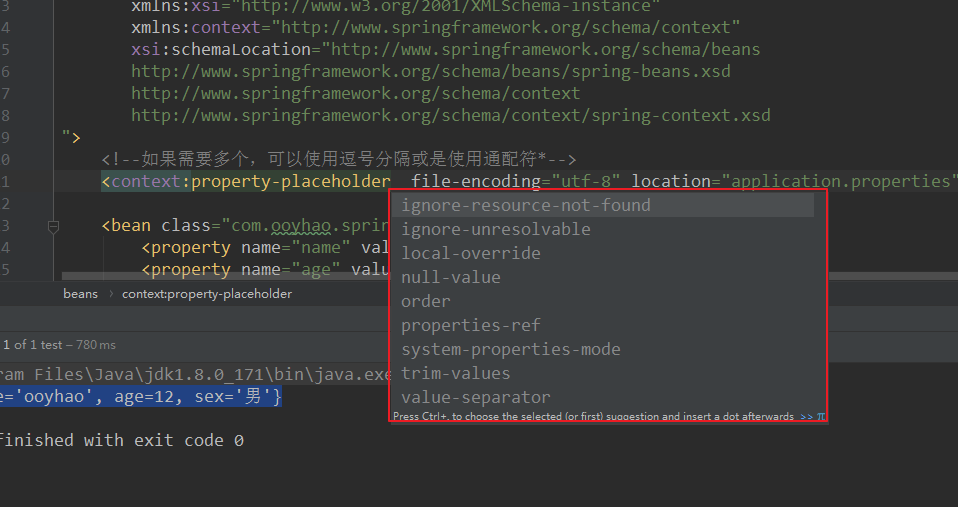高级装配
环境与Profile 在实际开发过程中,往往会将项目发布到不同的环境中,由于环境的不同,我们一般需要对在不同环境的数据和配置进行一些个性化的设定。比如,我们一般将开发到生产流程中的环境分为三种:开发(dev)、测试(test)和生产(prod)。而在这三种环境下,我们有些配置(如数据源)需要根据环境来切换。下面看看Spring中如何进行环境的个性化配置。
JavaConfig配置类 定义一个普通的User类:
1 2 3 4 5 6 7 8 9 10 11 12 13 14 15 16 17 18 19 20 21 22 23 24 25 26 27 28 29 30 31 32 33 34 35 36 37 38 39 40 41 42 43 44 45 public class User implements Serializable private String name; private Integer age; private String sex; public User () public User (String name, Integer age, String sex) this .name = name; this .age = age; this .sex = sex; } public String getName () return name; } public void setName (String name) this .name = name; } public Integer getAge () return age; } public void setAge (Integer age) this .age = age; } public String getSex () return sex; } public void setSex (String sex) this .sex = sex; } @Override public String toString () return "User{" + "name='" + name + '\'' + ", age=" + age + ", sex='" + sex + '\'' + '}' ; } }
BeanConfigA类:(使用@Profile 来指定环境,可以修饰在类上和方法上。此处只演示修饰在类上的,表示当前类中所有的Bean都只能在dev环境下,才能实例化到IoC容器中。当修饰在方法上,与@Bean配合使用时,将用更加细粒度的控制某一个类在某种环境下才能创建出来)
1 2 3 4 5 6 7 8 @Profile (value = "dev" )@Configuration public class BeanConfigA @Bean public User user () return new User("张三" ,23 ,"男" ); } }
BeanConfigB类:
1 2 3 4 5 6 7 8 @Profile (value = "prod" )@Configuration public class BeanConfigB @Bean public User user () return new User("李四" ,23 ,"男" ); } }
BeanConfig类:
1 2 @ComponentScan (basePackages = "com.ooyhao.spring" )public class BeanConfig
测试类:
1 2 3 4 5 6 7 8 9 10 11 12 13 @RunWith (SpringJUnit4ClassRunner.class ) @ContextConfiguration (classes = BeanConfig.class ) @ActiveProfiles (value = {"prod" })public class BeanConfigTest @Autowired private User user; @Test public void testProfile () System.out.println(user); } }
上面使用了在集成测试类上,适应@ActiveProfiles 注解来指定当前测试的环境。
Xml配置文件的方式 beanXmlConfig.xml文件:
1 2 3 4 5 6 7 8 9 10 11 12 13 14 15 16 17 18 19 20 21 22 23 24 25 26 27 28 <?xml version="1.0" encoding="UTF-8"?> <beans xmlns ="http://www.springframework.org/schema/beans" xmlns:xsi ="http://www.w3.org/2001/XMLSchema-instance" xsi:schemaLocation ="http://www.springframework.org/schema/beans http://www.springframework.org/schema/beans/spring-beans.xsd" > <beans profile ="dev" > <bean class ="com.ooyhao.spring.bean.User" > <property name ="name" value ="ouYanghao" /> <property name ="age" value ="23" /> <property name ="sex" value ="男" /> </bean > </beans > <beans profile ="prod" > <bean class ="com.ooyhao.spring.bean.User" > <property name ="name" value ="王五" /> <property name ="age" value ="30" /> <property name ="sex" value ="女" /> </bean > </beans > <beans profile ="test" > <bean class ="com.ooyhao.spring.bean.User" > <constructor-arg name ="name" value ="翠花" /> <constructor-arg name ="age" value ="28" /> <constructor-arg name ="sex" value ="女" /> </bean > </beans > </beans >
注意:
xml配置的方式可以看出:通过使用<beans> 标签中嵌套 <beans> 标签,并且使用 <beans> 标签的profile属性来指定环境。
激活Profile环境的几种方式 Spring在确定哪个Profile 处于激活状态时,需要依赖两个独立的属性:spring.profiles.active 和 spring.profiles.default . 如果设置了spring.profiles.active 属性的话,那么它的值就会用来确定哪个profile 是激活的。但是如果没有设置spring.profiles.active的话,那spring将会查找 spring.profiles.default 的值,如果spring.profiles.default 和 spring.profiles.active 的值均没设定时,那么久无法激活profile ,只有那些没有定义在任何profile中的Bean才会会创建。
有多种方式来设定这两个属性:
作为DispatcherServlet的初始化参数;
作为Web应用的上下文参数;
作为JNDI条目;
作为环境变量;
作为JVM的系统属性;
在集成测试类上,使用@ActiveProfiles 注解设置。
在Web.xml文件中设置:
Idea 中如何修改环境变量:
Idea 中如何修改JVM的系统变量:
在集成测试类上 ,使用@ActiveProfiles注解设置。
条件化的Bean 基本使用 在实际开发中,有时候需要控制某些Bean在某些特定的时候才创建,在Spring4之前很难实现这种条件化配置,但是spring4中引入了@Conditional 注解,他可以用到带有@Bean 注解的方法上,如果给定的条件计算结果为true,就会创建这个Bean,否则就会忽略这个Bean的创建。
下面我们以笔记本电脑和笔记本电池为案例,展开讲述 @Conditional 的使用,设定:笔记本创建时需要判断笔记本电池是否创建?
案例:当我们创建Computer类时,假设需要依赖于Battery类,如果当前容器中没有创建Battery实例,Computer就不创建了。
Computer 类:
1 2 3 4 5 6 7 8 9 10 public class Computer private String brand; private String name; private Battery battery; }
Battery 类:
1 2 3 4 5 6 7 8 9 public class Battery private String brand; private String name; }
ComputerCondition类:
通过使自定义Condition类实现Spring的Condition接口,并实现matches方法,依照其返回值true和false来判断标有@Conditional(ComputerCondition.class) 的bean是否创建。
1 2 3 4 5 6 7 8 9 10 11 12 13 14 15 16 public class ComputerCondition implements Condition public boolean matches (ConditionContext context, AnnotatedTypeMetadata metadata) try { ConfigurableListableBeanFactory factory = context.getBeanFactory(); Battery bean = factory.getBean(Battery.class ) ; System.out.println(bean); if (bean == null ) { return false ; } return true ; }catch (Exception e){ return false ; } } }
配置类:
1 2 3 4 5 6 7 8 9 10 11 12 13 14 15 16 public class BeanConfig public Battery battery () return new Battery("小米" ,"小米笔记本电池" ); } @Bean @Conditional (ComputerCondition.class ) public Computer computer (Battery battery ) { Computer computer = new Computer(); computer.setBrand("小米" ); computer.setName("小米笔记本" ); computer.setBattery(battery); return computer; } }
测试,将创建容器后用断点截断,查看:
测试结果可以直接查看Spring IoC容器中创建了哪些Bean。下图中的 BeanDefinitionMap 就是IoC容器存放Bean的一个地方。
而将配置类中创建电池方法的@Bean 注解注释取消之后,其结果如下图:
小案例 用@Conditional 注解来实现@profiles 功能,并且要求在不同的环境下 ,创建不同的Computer Bean。
DevCondition:
1 2 3 4 5 6 7 8 9 10 public class DevCondition implements Condition public boolean matches (ConditionContext context, AnnotatedTypeMetadata metadata) return context.getEnvironment().acceptsProfiles(new Profiles() { @Override public boolean matches (Predicate<String> activeProfiles) return activeProfiles.test("dev" ); } }); } }
TestCondition和ProdCondition只需要将上述代码中的dev改成test或是prod即可。
自定义注解,通过使用@Conditional 注解来标注,即相当于继承了@Conditional 注解,通过制定DevCondition.class. 表示当前注解条件判断是使用DevCondition中的逻辑来判断的。
1 2 3 4 5 @Target ({ElementType.METHOD,ElementType.TYPE})@Inherited @Retention (RetentionPolicy.RUNTIME)@Conditional (DevCondition.class ) public @interface DevConditional
@TestConditional 和 @ProdConditional 只需要修改其传入@Conditional 注解的类即可。
配置类:
1 2 3 4 5 6 7 8 9 10 11 12 13 14 15 16 17 18 19 20 21 22 23 24 25 26 27 28 29 30 31 32 33 34 35 36 37 38 public class BeanConfig @Bean public Battery battery () return new Battery("小米" ,"小米笔记本电池" ); } @Bean @DevConditional public Computer devComputer () Computer computer = new Computer(); computer.setBrand("小米" ); computer.setName("小米笔记本-DEV" ); computer.setBattery(battery()); return computer; } @Bean @TestConditional public Computer testComputer () Computer computer = new Computer(); computer.setBrand("小米" ); computer.setName("小米笔记本-TEST" ); computer.setBattery(battery()); return computer; } @Bean @ProdConditional public Computer prodComputer () Computer computer = new Computer(); computer.setBrand("小米" ); computer.setName("小米笔记本-PROD" ); computer.setBattery(battery()); return computer; } }
测试:通过前面的几种方式可以切换环境,可以测试出能够根据环境的不同产生不同的Computer。
matches方法 上面案例和介绍可以看出,通过@Conditional 以及配合Condition接口来实现工作是很简单的,实现Condition接口只需要实现matches方法即可,接下来我们来详细看一下matches方法传入的两个参数:ConditionContext 和AnnotatedTypeMetaData 。
ConditionContext ConditionContext是一个接口,源代码如下:
1 2 3 4 5 6 7 8 9 10 11 12 13 14 public interface ConditionContext BeanDefinitionRegistry getRegistry () ; @Nullable ConfigurableListableBeanFactory getBeanFactory () ; Environment getEnvironment () ; ResourceLoader getResourceLoader () ; @Nullable ClassLoader getClassLoader () ; }
通过ConditionContext,我们可以做到如下几点:
借助getRegistry()返回的BeanDefinitionRegistry检查bean定义;
借助getBeanFactory()返回的ConfigurableListableBeanFactory检查bean是否存在甚至探查bean的属性;
借助getEnvironment()返回的Environment检查环境变量是否存在以及它的值是什么;
读取并探查getResourceLoader()返回的ResourceLoader所加载的资源;
借助getClassLoader()返回的ClassLoader加载并检查类是否存在;
AnnotatedTypeMetaData则能够让我们检查带有@Bean 注解的方法上还有什么 注解。与ConditionContext一样,也是一个接口:
1 2 3 4 5 6 7 8 9 10 11 12 13 14 15 16 17 18 public interface AnnotatedTypeMetadata boolean isAnnotated (String annotationName) @Nullable Map<String, Object> getAnnotationAttributes (String annotationName) ; @Nullable Map<String, Object> getAnnotationAttributes (String annotationName, boolean classValuesAsString) ; @Nullable MultiValueMap<String, Object> getAllAnnotationAttributes (String annotationName) ; @Nullable MultiValueMap<String, Object> getAllAnnotationAttributes (String annotationName, boolean classValuesAsString) ; }
借助isAnntated()方法,我们能够判断带有@Bean 注解的方法是不是还有其他特定的注解。借助其他的那些方法,我们能够检查@Bean 注解的方法是不是还有其他注解。
其实@Profiles 注解也是使用了@Conditional 注解,并且引用ProfileCondition作为Condition实现,如下所示,ProfileCondition实现了Condition接口,并且在作出决策的过程中,考虑到了ConditionContext 和 AnnotatedTypeMetaData中的多个元素。
1 2 3 4 5 6 7 8 9 10 11 12 13 14 15 class ProfileCondition implements Condition @Override public boolean matches (ConditionContext context, AnnotatedTypeMetadata metadata) MultiValueMap<String, Object> attrs = metadata.getAllAnnotationAttributes(Profile.class .getName ()) ; if (attrs != null ) { for (Object value : attrs.get("value" )) { if (context.getEnvironment().acceptsProfiles(Profiles.of((String[]) value))) { return true ; } } return false ; } return true ; } }
处理歧义性Bean 当我们在注入Bean的时候,不管是byType,还是byName,如果遇到了两个相同的Bean的时候,Spring就会包NoUniqueBeanDefinitionException 即:不唯一的Bean的定义异常。
Animal:
1 public interface Animal
Cat:(省略无参构造,全参构造,getter,setter,toString方法,后面亦如此)
1 2 3 4 public class Cat implements Animal private String name; private Integer age; }
Dog:
1 2 3 4 public class Dog implements Animal private String name; private Integer age; }
Person:
1 2 3 4 public class Person private String name; private Animal pet; }
BeanConfig:
1 2 3 4 5 6 7 8 9 10 11 12 13 14 15 16 17 18 19 20 public class BeanConfig @Bean public Animal cat () return new Cat("小喵" ,3 ); } @Bean public Animal dog () return new Dog("小七" ,2 ); } @Bean public Person person (Animal animal) return new Person("张三" ,animal); } }
上述代码运行如下(报错:Bean定义不唯一异常,需要装配Animal,希望找到一个,但是发现了两个,cat,dog):
标注首选项 JavaConfig配置类形式 1 2 3 4 5 6 7 8 9 10 11 12 13 14 15 16 17 18 19 20 21 public class BeanConfig @Bean @Primary public Animal cat () return new Cat("小喵" ,3 ); } @Bean public Animal dog () return new Dog("小七" ,2 ); } @Bean public Person person (Animal animal) return new Person("张三" ,animal); } }
XML配置形式 multiBean.xml:
1 2 3 4 5 6 7 8 9 10 11 12 13 14 15 16 <?xml version="1.0" encoding="UTF-8"?> <beans xmlns ="http://www.springframework.org/schema/beans" xmlns:xsi ="http://www.w3.org/2001/XMLSchema-instance" xsi:schemaLocation ="http://www.springframework.org/schema/beans http://www.springframework.org/schema/beans/spring-beans.xsd" > <bean class ="com.ooyhao.spring.bean.Dog" primary ="true" > <property name ="name" value ="小小七" /> <property name ="age" value ="1" /> </bean > <bean class ="com.ooyhao.spring.bean.Cat" > <property name ="name" value ="小小喵" /> <property name ="age" value ="1" /> </bean > </beans >
XmlBeanConfig配置类:
1 2 3 4 5 6 7 8 @ImportResource ("classpath:multiBean.xml" )public class XmlBeanConfig @Bean public Person person (Animal animal) return new Person("王五" ,animal); } }
总结:
通过上述JavaConfig配置类或是Xml配置文件,可以发现,其实在遇到歧义性Bean的时候,可以通过标注首选项来解决,在JavaConfig配置类上使用@Primary 注解 或是在 Xml配置文件在bean标签中使用primary=true 来实现。
限制自动装配的Bean 如果在实际项目中byType注入的时候出现多个相同的Bean的时候,我们可以通过ID的形式注入。如下:
在Cat和Dog类上使用@Component 注解标注,Person类如下:
1 2 3 4 5 6 7 8 9 10 11 @Component public class Person private String name; @Resource (name = "dog" ) private Animal pet; }
通过使用@Autowired 和 @Qualifier 配合使用,并在Qualifier中指定Bean的ID。或者使用@Resource注解,在其name属性指定bean 的Id。
这里特别注释一下这几个注解的注入方式:
默认是byType 进行装配的,如果在IoC容器中存在两个或两个以上的Bean类型一致时,Autowired会转变为byName进行装配,如果此时相同类型的Bean的ID存在0个或两个以两个以上与需要注入属性的名字一致,则会抛出 NoUniqueBeanDefinitionException 异常。如果此时需要装配Bean的ID与属性名不一致,可以配合@Qualifier 注解来标注。
@Resource其实与@Autowired的作用是一致的,都是用来装配Bean的,但是@Resource默认是byName来装配的,@Resource有两个比较 重要的属性,一个是name,一个是type,如果指定name,其实就是使用byName进行装配,如果指定type,则是使用byType进行装配。
装配顺序如下:
如果同时指定了name和type,则从Spring上下文中找到唯一匹配的bean进行装配,找不到则抛出异常。
如果指定了name,则从上下文中查找名称(id)匹配的Bean进行装配,否则就抛出异常。
如果指定了type,则从上下文中查找类型匹配的唯一bean进行装配,找不到或者多个,都会抛出异常。
如果既没有指定name,又没有指定type,则自动按照byName方式进行装配;如果没有匹配,则回退为类型匹配,如果匹配则自动装配。
注意:
1和2 示例中,使用@Qualifier注解只是为Dog对象打一个标注,并不是将Dog对象的ID由dog变成了pet,所以,如果在注入的时候,仅是使用2中的代码依旧会抛出异常,需要使用3中的代码,即需要在注入的时候加上这个标注。如果需要使用2中的代码,则需要将Dog的ID由dog修改为pet,即直接在@Component的value中指定为pet即可。
1 2 3 4 5 6 7 8 9 10 11 12 13 14 15 16 17 18 19 20 21 22 23 24 25 26 27 28 29 30 31 32 33 34 35 36 37 @Component @Qualifier ("pet" )public class Dog implements Animal private String name; private Integer age; } @Component public class Person private String name; @Autowired private Animal pet; } @Component public class Person private String name; @Autowired @Qualifier ("pet" ) private Animal pet; } @Component ("pet" )public class Dog implements Animal private String name; private Integer age; }
由于@Qualifier的注解只是将Bean打上一个标注,而如果遇到两个或两个以上的Bean打了一个相同的标注,此时又无法实现装配了,有人可能会说,一个不够,那就多打几个。由图片可以看出,不支持标注多个@Qualifier的注解,否则会报编译异常。那么如何解决呢?
上述问题可以通过自定义注解来解决,自定义注解结合@Qualifier注解实现,如下:
IPet注解:
1 2 3 4 @Target ({ElementType.METHOD,ElementType.TYPE,ElementType.FIELD})@Retention (RetentionPolicy.RUNTIME)@Qualifier public @interface IPet {}
ICat注解:
1 2 3 4 @Target ({ElementType.METHOD,ElementType.TYPE,ElementType.FIELD})@Retention (RetentionPolicy.RUNTIME)@Qualifier public @interface ICat {}
IDog注解:
1 2 3 4 @Target ({ElementType.METHOD,ElementType.TYPE,ElementType.FIELD})@Retention (RetentionPolicy.RUNTIME)@Qualifier public @interface IDog {}
Cat类:
1 2 3 4 5 6 7 @Component @IPet @ICat public class Cat implements Animal private String name; private Integer age; }
Dog类:
1 2 3 4 5 6 7 @Component @IPet @IDog public class Dog implements Animal private String name; private Integer age; }
Person类使用:
1 2 3 4 5 6 7 8 9 10 @Component public class Person private String name; @Autowired @IPet @IDog private Animal pet; }
测试结果如下:
Bean的作用域 Bean的作用域分为四种:singleton, prototype, session, request.
singleton:单例,默认,即每次从容器中获取的对象都是同一个
prototype:多例(原型),即每次从容器中获取的对象都是不一样的。
session:回话,用于web环境,一次session回话是同一个对象。
request:请求,用于web环境,一次request请求是同一个对象。
常见的作用域是singleton和prototype,下面主要是演示下面两种:
Java配置类形式 singleton作用域:
1 2 3 4 5 6 @Component @Scope (ConfigurableBeanFactory.SCOPE_SINGLETON)public class Cat implements Animal private String name; private Integer age; }
prototype作用域:
1 2 3 4 5 6 @Component @Scope (ConfigurableBeanFactory.SCOPE_PROTOTYPE)public class Dog implements Animal private String name; private Integer age; }
BeanConfig 配置类:
1 2 @ComponentScan (basePackages = "com.ooyhao.spring" )public class BeanConfig
测试类:
1 2 3 4 5 6 7 8 9 10 11 12 13 14 15 16 public class ScopeTest @Test public void testScope () AnnotationConfigApplicationContext context = new AnnotationConfigApplicationContext(BeanConfig.class ) ; Cat bean1 = context.getBean(Cat.class ) ; Cat bean2 = context.getBean(Cat.class ) ; System.out.println(bean1 == bean2); Dog dog1 = context.getBean(Dog.class ) ; Dog dog2 = context.getBean(Dog.class ) ; System.out.println(dog1 == dog2); } }
Xml配置文件形式 Bean类:
1 2 public class Computer public class MobilePhone
scope.xml配置文件:
1 2 3 4 5 6 7 8 9 10 <?xml version="1.0" encoding="UTF-8"?> <beans xmlns ="http://www.springframework.org/schema/beans" xmlns:xsi ="http://www.w3.org/2001/XMLSchema-instance" xsi:schemaLocation ="http://www.springframework.org/schema/beans http://www.springframework.org/schema/beans/spring-beans.xsd" > <bean class ="com.ooyhao.spring.bean.Computer" scope ="singleton" /> <bean class ="com.ooyhao.spring.bean.MobilePhone" scope ="prototype" /> </beans >
测试类:
1 2 3 4 5 6 7 8 9 10 11 12 @Test public void testXmlConfig () ClassPathXmlApplicationContext context = new ClassPathXmlApplicationContext("scope.xml" ); Computer computer1 = context.getBean(Computer.class ) ; Computer computer2 = context.getBean(Computer.class ) ; System.out.println(computer1 == computer2); MobilePhone mobilePhone1 = context.getBean(MobilePhone.class ) ; MobilePhone mobilePhone2 = context.getBean(MobilePhone.class ) ; System.out.println(mobilePhone1 == mobilePhone2); }
运行时注入值 Spring 提供了两种在运行时求的方式:
属性占位符(${})
Spring表达式语言(#{})
https://www.cnblogs.com/slowcity/p/9097969.html
注入外部值 在Spring中,处理外部值的最简单方式就是声明属性源并通过Spring的Environment来检索属性。
application.properties文件:
1 2 3 name =ooyhao age =12 sex =男
通过使用@PropertySource注解,将指定下的文件(此例:application.properties)会被加载到Spring的Environment中,稍后可以从这里检索属性。
UserConfig配置文件:
1 2 3 4 5 6 7 8 9 10 11 12 13 14 15 16 @PropertySources ( @PropertySource (value = "classpath:application.properties" ,encoding = "utf-8" ) ) public class UserConfig @Autowired private Environment environment; @Bean public User user () String name = environment.getProperty("name" ); Integer age = Integer.valueOf(environment.getProperty("age" )); String sex = environment.getProperty("sex" ); return new User(name,age,sex); } }
深入学习Environment 通过打印上述代码中自动注入的Environment可以看出,注入的其实是:org.springframework.core.env.StandardEnvironment. 而它有继承自AbstractEnvironment .
AbstractEnviroment 部分方法:
1 2 3 4 5 6 7 8 9 10 11 12 13 14 15 16 17 18 19 20 21 22 23 24 25 26 27 28 29 30 31 32 33 34 35 36 37 38 39 40 41 42 43 44 45 46 47 48 49 50 51 52 53 54 55 56 public abstract class AbstractEnvironment implements ConfigurableEnvironment public String[] getActiveProfiles() {} protected Set<String> doGetActiveProfiles () public void setActiveProfiles (String... profiles) public void addActiveProfile (String profile) public String[] getDefaultProfiles() {} protected Set<String> doGetDefaultProfiles () public void setDefaultProfiles (String... profiles) public boolean acceptsProfiles (Profiles profiles) protected boolean isProfileActive (String profile) protected void validateProfile (String profile) public MutablePropertySources getPropertySources () public Map<String, Object> getSystemProperties () public Map<String, Object> getSystemEnvironment () public void setRequiredProperties (String... requiredProperties) public void validateRequiredProperties () throws MissingRequiredPropertiesException {} public boolean containsProperty (String key) public String getProperty (String key) public String getProperty (String key, String defaultValue) public <T> T getProperty (String key, Class<T> targetType) {} public <T> T getProperty (String key, Class<T> targetType, T defaultValue) {} public String getRequiredProperty (String key) throws IllegalStateException public <T> T getRequiredProperty (String key, Class<T> targetType) throws IllegalStateException {}}
直接从 Environment 中检索属性是十分方便的,尤其是在Java配置中装配Bean的时候。但是,Spring也提供了通过占位符装配属性的方法,这些占位符的值会来源于一个属性源。
解析属性占位符 Spring 一直支持将属性定义在外面的属性文件中,并使用占位符值将其插入到Spring Bean中。在Spring装配中,占位符的形式为使用${} 包装的属性名称。
1 2 3 4 5 6 7 8 9 10 11 12 13 14 15 16 17 18 19 20 21 22 23 24 25 26 27 28 public class UserConfig @Bean public PropertySourcesPlaceholderConfigurer placeholderConfigurer () PropertySourcesPlaceholderConfigurer configurer = new PropertySourcesPlaceholderConfigurer(); Resource resource = new ClassPathResource("application.properties" ); configurer.setLocations(resource); return configurer; } @Value ("${name}" ) private String name; @Value ("${age}" ) private Integer age; @Value ("${sex}" ) private String sex; @Bean public User user () return new User(name,age,sex); } }
上面提供了两种方式,一种是使用@PropertySources注解,一种是通过创建PropertySourcesPlaceholderConfigurer来指明属性文件的相关信息。
测试:
1 2 3 4 5 6 7 @Test public void testProperties () AnnotationConfigApplicationContext context = new AnnotationConfigApplicationContext(UserConfig.class ) ; User bean = context.getBean(User.class ) ; System.out.println(bean); }
当然也可以使用Xml文件的形式:
1 2 3 4 5 6 7 8 9 10 11 12 13 14 15 16 17 18 <?xml version="1.0" encoding="UTF-8"?> <beans xmlns ="http://www.springframework.org/schema/beans" xmlns:xsi ="http://www.w3.org/2001/XMLSchema-instance" xmlns:context ="http://www.springframework.org/schema/context" xsi:schemaLocation ="http://www.springframework.org/schema/beans http://www.springframework.org/schema/beans/spring-beans.xsd http://www.springframework.org/schema/context http://www.springframework.org/schema/context/spring-context.xsd" > <context:property-placeholder file-encoding ="utf-8" location ="application.properties" /> <bean class ="com.ooyhao.spring.bean.User" > <property name ="name" value ="${name}" /> <property name ="age" value ="${age}" /> <property name ="sex" value ="${sex}" /> </bean > </beans >
可以看出,除了上述例子中的属性,还包含更多的属性,比如ignore-resource-not-found和ignore-unresolvable 等属性。上述文件中说明了如何指定多个属性文件。
1 2 <context:property-placeholderlocation="classpath:db.properties,classpath:monitor.properties" /> <context:property-placeholderlocation="classpath:*.properties" />
属性解释:
1 2 ignore-resource-not-found ignore-unresolvable
Spring Expression Language 介绍 Spring Expression Language :缩写 SpEL。Spring3引入的,它能够以一种强大和简洁的方式将值装配到Bean属性和构造器参数中,在这个过程中所使用的表达式会在运行时 计算得到值。使用SpEL,我们可以实现超乎想象的装配效果,这是使用其他的装配技术难以做到的。
SpEL拥有很多特性,包括:
小试牛刀 下面的结果是:Hello World!
1 2 3 ExpressionParser parser = new SpelExpressionParser(); Expression expression = parser.parseExpression(" 'Hello World'.concat('!') " ); System.out.println(expression.getValue());
下面的结果是:5
1 2 3 4 ExpressionParser parser = new SpelExpressionParser(); Expression expression2 = parser.parseExpression(" 'Hello'.bytes.length " ); System.out.println(expression2.getValue());
下面的结果:HELLO
1 2 3 ExpressionParser parser = new SpelExpressionParser(); Expression expression3 = parser.parseExpression(" 'hello'.toUpperCase() " ); System.out.println(expression3.getValue());
Xml文件配置 1 2 3 4 5 6 7 8 9 10 11 12 13 14 15 16 17 <?xml version="1.0" encoding="UTF-8"?> <beans xmlns ="http://www.springframework.org/schema/beans" xmlns:xsi ="http://www.w3.org/2001/XMLSchema-instance" xsi:schemaLocation ="http://www.springframework.org/schema/beans http://www.springframework.org/schema/beans/spring-beans.xsd" > <bean id ="address" class ="com.ooyhao.spring.bean.Address" > <property name ="id" value ="#{T(java.lang.Math).random() *10 }" /> <property name ="name" value ="上海" /> </bean > <bean class ="com.ooyhao.spring.bean.User" > <property name ="name" value ="ooyhao" /> <property name ="age" value ="#{T(java.lang.Math).random() *100 }" /> <property name ="addrName" value ="#{address.name}" /> </bean > </beans >
Java类注解配置 在属性上使用:
1 2 3 4 5 6 7 8 9 10 11 12 13 14 15 16 17 18 19 20 21 public class SpELConfig @Value ("#{T(java.lang.Math).random() * 10}" ) private Integer id; @Value ("北京" ) private String addrName; @Value ("#{address.name}" ) private String address; @Bean public Address address () return new Address(id,addrName); } @Bean public User user () return new User("1" ,23 ,address); } }
在方法上使用 :
1 2 3 4 @Value ("#{address.name}" )public void setAddrName (String addrName) this .addrName = addrName; }
在构造方法上使用:
注意:在构造方法上使用,需要与@Autowired 配合使用,并且如果需要使用,则全部都需要注入,单个注入会报编译错误。
1 2 3 4 5 6 7 8 9 10 11 12 13 14 15 16 17 18 19 20 21 22 23 24 25 26 27 28 29 30 31 32 33 34 35 36 37 38 39 40 41 42 43 44 45 46 47 48 49 50 51 52 53 54 55 56 57 58 59 60 @Component public class User @Value ("#{'林黛玉'}" ) private String name; @Value ("#{T(java.lang.Math).random() * 4 + 16}" ) private Integer age; private String addrName; public User () @Autowired public User (@Value("#{address.name}" ) String addrName) this .addrName = addrName; } public User (String name, Integer age,String addrName) this .name = name; this .age = age; this .addrName = addrName; } public String getName () return name; } public void setName (String name) this .name = name; } public Integer getAge () return age; } public void setAge (Integer age) this .age = age; } public String getAddrName () return addrName; } public void setAddrName (String addrName) this .addrName = addrName; } @Override public String toString () return "User{" + "name='" + name + '\'' + ", age=" + age + ", addrName='" + addrName + '\'' + '}' ; } }
SpEL所支持的参考文档和文档:
https://docs.spring.io/spring/docs/5.1.9.RELEASE/spring-framework-reference/core.html#expressions-language-ref
https://blog.csdn.net/fanxiaobin577328725/article/details/68942967
支持:(下面仅测试部分类型,具体详细的可以查看Spring官方文档)
字面量 1 2 3 4 5 6 7 8 9 10 11 12 ExpressionParser parser = new SpelExpressionParser(); String helloWorld = (String) parser.parseExpression("'Hello World'" ).getValue(); double avogadrosNumber = (Double) parser.parseExpression("6.0221415E+23" ).getValue();int maxValue = (Integer) parser.parseExpression("0x7FFFFFFF" ).getValue();boolean trueValue = (Boolean) parser.parseExpression("true" ).getValue();Object nullValue = parser.parseExpression("null" ).getValue();
也可以写作:
1 2 3 4 5 6 7 8 9 10 11 12 13 14 @Value (" 'Hello World' " )private String hello;@Value ("6.0221415E+23" )private Double num;@Value ("0x7FFFFFFF" )private Integer maxValue;@Value ("true" )private Boolean bool;@Value ("null" )private Object oNull;
对象 调用对象,对象的属性,对象的方法。 [?.] 会先判断问号左边是否为空,是则直接注入null,不在调用右边的方法。
1 2 3 4 5 6 7 8 9 10 11 12 13 14 15 16 17 18 19 @Value ("#{user}" )private User user;@Value ("#{user.name}" )private String userName;@Value ("#{user.name.toUpperCase()}" )private String nameUp;@Value ("#{user.getAddrName().toUpperCase()}" )private String addrUp;@Value ("#{user.getName() ?.toUpperCase()}" ) private String upName;@Bean public User user () return new User(null ,23 ,"shanghai" ); }
类型 1 2 3 4 5 @Value ("#{T(java.lang.Math).PI}" )private Double pi;@Value ("#{T(java.lang.Math).random() * 100}" )private Integer randomNum;
运算符
运算符类型
运算符
算数运算符
+、-、*、/、%、^
比较运算符
<、>、==、<=、>=、lt、gt、eq、le、ge
逻辑运算
and、or、not、|
条件元素符
?:(ternary)、?:(Elvis)
正则表达式
matches
集合计算 1 2 3 4 5 6 7 8 9 10 11 12 13 14 15 16 17 18 19 20 21 22 23 24 25 26 27 28 29 30 31 32 33 34 35 36 37 38 39 40 41 42 43 44 45 46 47 48 49 50 51 52 53 54 55 56 57 58 @Value ("#{ user.mobilePhone[1].getName() }" )private String name;@Value ("#{ user.mobilePhone[1].getColors()[0] }" )private String color;@Value ("#{ user.mobilePhone.?[name eq '华为手机' ] }" )private List<MobilePhone> mobilePhone;@Value ("#{ user.mobilePhone.![name] }" )private List<String> names;@Value ("#{ user.mobilePhone.^[name eq '小米手机'] }" )private MobilePhone mobilePhone1;@Value ("#{ user.mobilePhone.$[name eq '小米手机'] }" )private MobilePhone mobilePhone2;@Bean public MobilePhone huaWei () MobilePhone mobilePhone = new MobilePhone(); mobilePhone.setName("华为手机" ); List<String> colors = new ArrayList<String>(); colors.add("Blue" ); colors.add("Yellow" ); colors.add("Green" ); mobilePhone.setColors(colors); return mobilePhone; } @Bean public MobilePhone xiaoMi () MobilePhone mobilePhone = new MobilePhone(); mobilePhone.setName("小米手机" ); List<String> colors = new ArrayList<String>(); colors.add("Pink" ); colors.add("Red" ); colors.add("White" ); mobilePhone.setColors(colors); return mobilePhone; } @Bean public MobilePhone xiaoO () MobilePhone mobilePhone = new MobilePhone(); mobilePhone.setName("小米手机" ); List<String> colors = new ArrayList<String>(); colors.add("black" ); colors.add("cyan" ); colors.add("orange" ); mobilePhone.setColors(colors); return mobilePhone; }
总结:
本节基于上节的基础上,进一步了解了Spring的装配特性,从上一节中如何装配Bean到这一节的条件化Bean,歧义性Bean和外部属性值,以及Spring Expression Language 的使用。至此,Spring的IoC部分的大多数知识也已经涉及到,至于高级API知识和源码分析等就不再深入,等本人达到一定水平后,在回头研究Spring或SpringBoot,这一系列主要是基于Spring-in-Action这本书所记录的笔记,系统的复习和再次深入学习一遍。

